

 By Frank Doris, July 2020
By Frank Doris, July 2020
Carl Marchisotto is the president of Holbrook, NY-based Accent Speaker Technology, manufacturers of NOLA loudspeakers. Before then, Marilyn and Carl owned Acarian Systems, makers of Alon speakers, and Carl worked for Dahlquist and others.
NOLA offers loudspeakers for stereo and multichannel listening. Available in a variety of finishes, NOLA models range from the $2,500 per pair Boxer 3 compact speaker to the flagship Grand Reference VI Gold, a $450,000 system featuring two main and two subwoofer towers plus two external crossover units with isolation platforms.
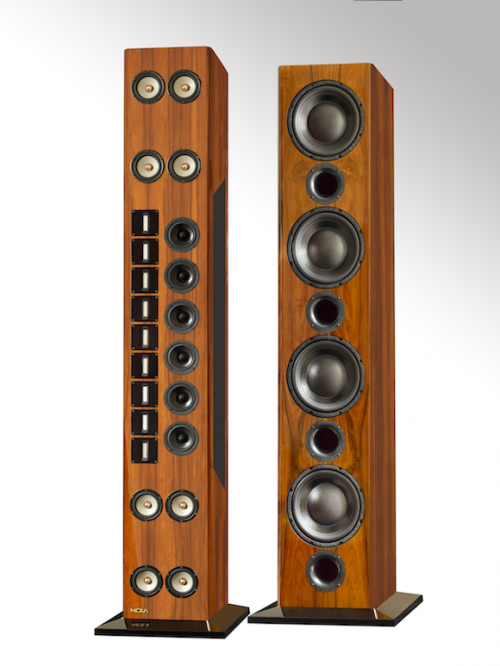
NOLA Grand Reference VI Gold
Carl Marchisotto: It was a love of music that got me interested in its reproduction. I studied piano for 12 years and my father played violin. My mother brought me to the old Metropolitan Opera House often. I became used to the sound of live music at an early age.
I became fascinated with loudspeakers while in high school. I built a pair of 12-cubic-foot bass reflex enclosures to go with Whiteley Stentorian 12 inch coaxial drivers. Fortunately my Dad was into woodworking, which made this possible.
In the late 1960s I worked as an engineer for Fairchild Defense. After hours, while at home, I developed a musical effects device that could sustain guitar notes.
We showed it to [guitar manufacturer] Gibson and they bought it. They named it the Maestro Sustainer. I then left Fairchild in 1971 to start All Test Devices with my wife Marilyn and another partner to produce the Sustainer for Gibson, in addition to other musical effects devices. I also developed the All Test Phono Preamp model ATD 25 and this product got me closer to reproducing music – my first love. We later sold our company to my partner and in 1976 I joined Dahlquist.
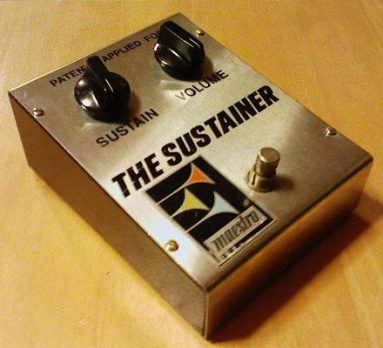
An early-version Maestro Sustainer
CM: Dahlquist was a one-product company at the time I joined it. I developed all the products that came after the original DQ-10 loudspeaker, including the mirror-image and mylar cap kits. (The earlier DQ-10s had drivers that were in the same orientation regardless of whether the speaker was used for the left or right channel. Carl's revision oriented the speaker drivers in matched, mirror-image pairs, which improved imaging and soundstaging. – FD)
I developed two lines of enclosure-type loudspeakers encompassing some eight models in the M Series and the M900 Series.
I was there for 15 years and developed the DQ-8, DQ-12 and DQ-20i in the open-baffle range. Then unfortunately Jon had an automobile accident which left him debilitated and the company was sold.
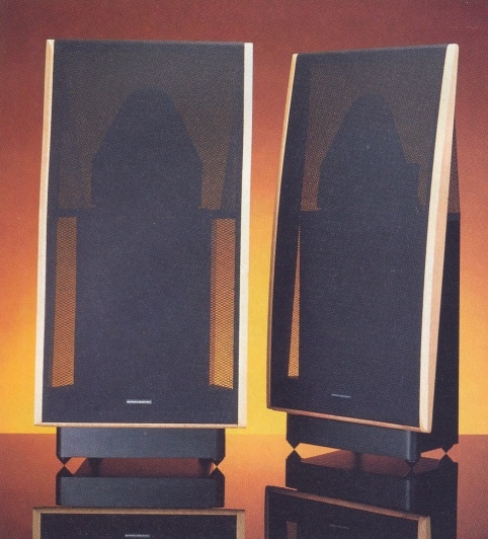
Dahlquist DQ-20
Dahlquist became a totally different company when the corporate types (aka The Suits) took over. They told me which tweeter I had to use and that it could cost $7 max! They only saw cost, with sound quality second.
FD: What made you decide to leave and start Acarian Systems, later Accent Speaker Technology?
CM: The new management and I were not a good fit, to say the least. I convinced them to pay me full salary and benefits for nine months if I left. They agreed. I used the time off to develop a new loudspeaker. Marilyn and I formed Acarian Systems to produce it.
We named it the Alon IV. There was also a third partner involved in Acarian. Over time this third partner became more and more greedy – until it became impossible to continue – and this caused Marilyn and me to leave Acarian Systems.
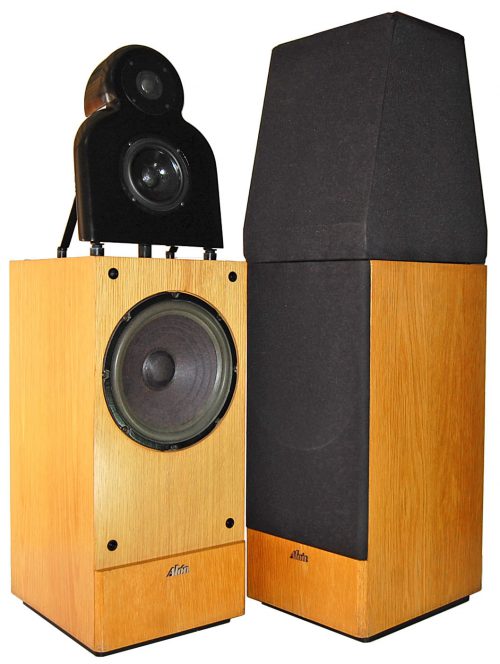
Alon IV
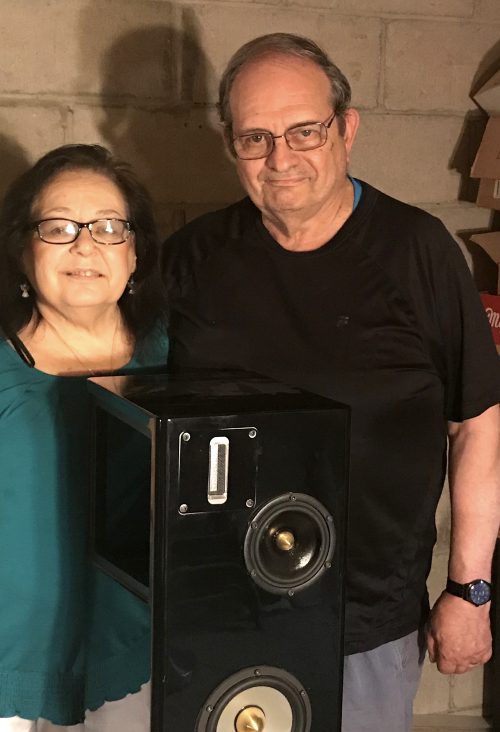
Marilyn and Carl Marchisotto
CM: I prefer the open baffle design for midrange drivers and tweeters because this provides a sound that is closest to the sound of live music. The difference in sound is not subtle. Many times at shows, visitors told us they came into our room because of the sound they heard in the hallway – outside our demo room. However, since there is no rear air load on the driver to control the driver, as in a box speaker, special drivers are required. These turn out to be more expensive, but worth it to my ear.
In addition, there is no way to completely absorb a driver's rear wave in a box speaker, and so the delayed rear radiation is reflected back through the cone, and this colors the sound.
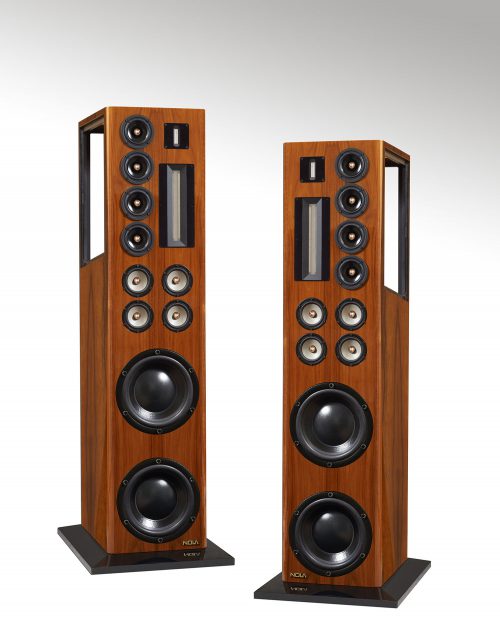
NOLA Concert Grand Reference Gold 2
CM: We have our own topology, which we developed. We named it Unison. Except for some subwoofer applications, I do not agree with using 24 dB/octave slopes for bass, midrange or high frequencies. This is due to the deleterious effects of such a slope to the transient response and efficiency of the system. We also do not agree with the very shallow 6 dB/octave crossover slopes.
FD: What do you like for driver materials? I know you're a big fan of alnico magnets.
CM: We use Alnico-magnet systems in our best drivers, despite the high cost, because they provide the most lifelike sound. However, they are too large to use in the True Ribbon tweeters used in the Reference models, so we use high-grade neodymium for the ribbons instead.
Our best speakers use metal cone woofers, coated paper cone midrange drivers and aluminum True Ribbon tweeters. Our less-costly models use silk dome tweeters. When developing the Gold series of our Reference loudspeakers, we decided to gold-plate the copper phase plugs for cosmetic reasons. Much to our surprise, the gold plating improved the sound of the solid copper phase plugs! We continue to gold-plate them.
FD: What do you think sets NOLA speakers apart?
CM: I think what sets NOLA apart is that my goal is to duplicate the experience, at home, of listening to the live event. Naturally the more ambitious models come closer to achieving this goal.
But even with the Boxer 3, our least-costly model, I have spent a great deal of time listening and optimizing the sound during its development. I listen to everything that affects sound – including types of adhesives (we use different ones in different places), types of rubber, fastening devices, component mounting techniques, and cabinet materials and finishes, in addition to the usual list of things like drivers, crossover components, solder and speaker terminals.
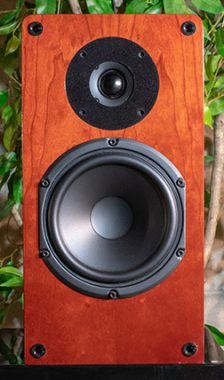
NOLA Boxer 3
FD: What are some memorable moments you can tell us about?
CM: Listening to Saul Marantz at Dahlquist telling me about the time he told Sid Smith how to get the phono noise down on the Marantz Model 7 preamplifier. Saul had this gift of asking a few questions and then being able to reduce a complex issue to a more fundamental one, wherein the solution to a problem became apparent. It is not that Saul told the engineers what to do, but instead, that he created an environment where his interaction allowed the engineer to perform at his best. I can still hear the unmistakable sound of the "clink" from Saul's Zippo lighter.
Listening together with the late great Harry Pearson – he was only interested in the sound produced and not by what or who made it. And if he was not happy, he would have no problem in letting you know. He was usually right. Fortunately, he always seemed to like what I designed. He was gifted in not only what he heard but also in being able to describe the sound in words in such a way that resonated with readers.
During the Acarian days, in conjunction with the late beloved Victor Goldstein [see our tribute to Victor in Issue 111], Victor made arrangements so that he and I were able to set up and to demonstrate the Alon V loudspeaker to the orchestra members of the New York Philharmonic. I remember one of the orchestra members saying to me, after the demo, "I cannot believe that I can now hear the difference between a Steinway and a Baldwin." This unexpected comment meant a great deal to me.
FD: That must have been gratifying!
CM: Then there was the time at Dahlquist I had a big shot from our German driver manufacturer ask me at CES as I was taking a speaker apart, "Is it broken?" "No," I said, "just modifying it."
I had not finished the design of a new model before it was time to ship it to CES. I had not decided whether I liked the sound with the brace installed. So I glued in the brace and shipped it to the show. As it turned out I did not want the brace, so at CES I was wielding a hammer at the cabinet – bang bang, bang! – just as the big shot guest walked in!
Once at Dahlquist Jon got the bright idea that we should line a cabinet with black top for damping the inside of the walls. So we followed a black top truck through the neighborhood and got them to give us a pail of black top. We then brought it to Jon's kitchen and microwaved it! Well, he was the boss! What a mess and a smell! Not good!
We never did get to listen to it.
Then there was another time at Dahlquist when we were developing the DQ-1W subwoofer. Jon decided that the Marchisotto's apartment had the best bass characteristics, so we had to do all the listening in that apartment, much to my wife's surprise. Jon, not known for quick decisions, had us build 16 different subwoofer designs – all brought to our small apartment on the second floor. The net result, after we managed to knock all the glasses out of the next door lady's china closet, was that she threatened to call the police! I guess she was not an audiophile.
At Acarian we once shipped about 15 pairs of Alon I speakers to our Thailand distributor. Only one problem: our manufacturing partner forgot to glue in place the bottoms of all the cabinets, so once the speakers got to Thailand all the bottoms fell out. The irresponsible partner's response was, "so send them some screws." Needless to say we lost the distributor.
FD: Even before the COVID-19 crisis, some brick and mortar dealers were struggling. How has NOLA been handling the situation? Any plans to sell direct, or maybe do a combination of online and retail?
CM: We do offer direct sales to our customers in areas where there is no dealer nearby.
FD: Anything else you'd like to add?
CM: I think there is a fundamental difference between NOLA and other speaker manufacturers. As I mentioned, I have had a consistent goal for the sound of our speakers to re-create the live sound experience in the home. This concept has followed me through more than three companies, dating back from before the Dahlquist DQ-10 up to the NOLA Grand Reference VI Gold. I think the most important consideration in buying a loudspeaker is if you agree with the designer, in the same way that you agree with the chef when choosing a restaurant.
I think product reviews may be more important now than ever. This is because there are now fewer local dealers for a customer to visit and audition the product in person. Sadly, there seems also to be fewer reviews that describe the sound of the product in such a way that reading the review would give a potential buyer the critical information he or she seeks.
FD: Is there anything new on the horizon you can tell us about? Any big surprises in the works?
CM: The most exciting new development at NOLA is our Studio Grand Reference Gold 2. I was very happy and excited to hear that the prototype performed as I had envisioned. The soundscape was huge in a relatively small room with images that suspended out in front of and behind the speaker into a 3-dimensional palpable space. Using just one exotic super-Alnico bass driver, bass response has been extended to 28Hz. We hope to share this experience of the Studio Grand Reference Gold 2 at the next live audio show.
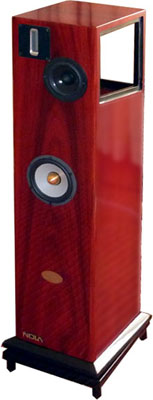
NOLA Studio Grand Reference Gold 2
Like some of our great music composers, there is no doubt that Carl has that gift for hearing the music in his head before his design is even put down on paper. He has often discussed a design he's had in his head with me, and that he just knows the speakers will make the same musical sounds once they're built. And much to my astonishment, he always succeeds. Our family is so proud of his work and dedication to his passion for music. Over the years, he has shared this passion with me and has passed down this passion to his daughters as well.
Accent Speaker Technology, Ltd.
1511 Lincoln Avenue
Holbrook, NY 11741
631-738-2540
info@NolaSpeakers.com
www.nolaspeakers.com
Header image: NOLA Announcer 2, center channel speaker.